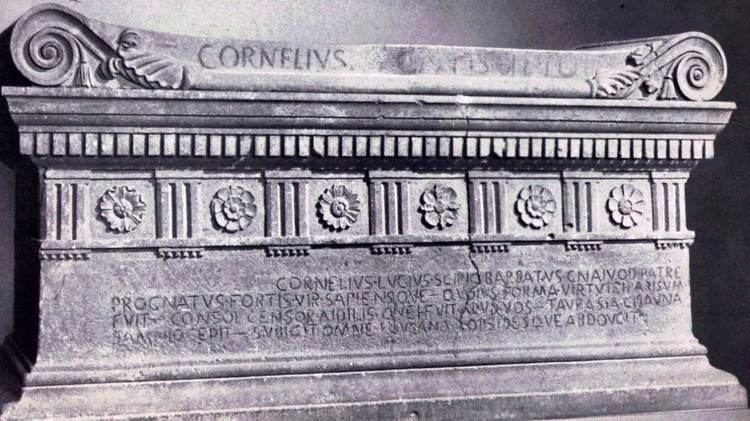 | ||
Saturnian meter or verse is an old Latin and Italic poetic form, of which the principles of versification have become obscure. Only 132 complete uncontroversial verses survive. 95 literary verses and partial fragments have been preserved as quotations in later grammatical writings, as well as 37 verses in funerary or dedicatory inscriptions. The majority of literary Saturnians come from the Odysseia (more commonly known as the Odissia or Odyssia), a translation/paraphrase of Homer's Odyssey by Livius Andronicus (c. 3rd century BC), and the Bellum Poenicum, an epic on the First Punic War by Gnaeus Naevius (c. 3rd century BC).
Contents
- The Saturnian as quantitative
- Examples
- The Saturnian as accentual
- The Saturnian in non Latin Italic
- Prehistory of the Saturnian
- References
The meter was moribund by the time of the literary verses and forgotten altogether by classical times, falling out of use with the adoption of the hexameter and other Greek verse forms. Quintus Ennius is the poet who is generally credited with introducing the Greek hexameter in Latin, and dramatic meters seem to have been well on their way to domestic adoption in the works of his rough contemporary Plautus. These Greek verse forms were considered more sophisticated than the native tradition; Horace called the Saturnian horridus. Consequently, the poetry in this meter was not preserved. Cicero regretted the loss in his Brutus:
Atque utinam exstārent illa carmina, quae multīs saeclīs ante suam aetātem in epulīs esse cantitāta ā singulīs conuīuīs dē clārōrum uirōrum laudibus in Orīginibus scrīptum relīquit Catō.However, it has been noted that later poets like Ennius (by extension Virgil, who follows him in both time and technique) preserve something of the Saturnian aesthetic in hexameter verse. Ennius explicitly acknowledges Naevius' poem and skill (lines 206–7 and 208–9 in the edition of Skutsch, with translations by Goldberg):
[...] scrīpsēre aliī remuorsibus quōs ōlim Faunei uātesque canēbantnam neque Mūsārum scopulōs ēscendit ad altōsnec dictī studiōsus fuit Rōmānus homō ante hunc.Ancient grammarians sought to derive the verse from a Greek model, in which syllable weight or the arrangement of light and heavy syllables was the governing principle. Scholars today remain divided between two approaches:
- The meter was quantitative (but not borrowed from Greek).
- The meter was accentual or based on accented and unaccented syllables.
Despite the division, there is some consensus regarding aspects of the verse's structure. A Saturnian line can be divided into two cola or half-lines, separated by a central caesura. The second colon is shorter than or as long as the first. Furthermore, in any half-line with seven or more syllables, the last three or four are preceded by word-end. This is known as Korsch's caesura or the caesura Korschiana, after its discoverer.
The Saturnian as quantitative
Most—but not all—Saturnians can be captured by the following scheme:
Examples
Numeration of literary fragments is according to Warmington's edition; translations are also by Warmington (see bibliography infra).
(1) Livius Andronicus, Odissia fragment 1
(2) Naevius, Bellum Poenicum fragments 2–4
(3) Epitaph for Lucius Cornelius Scipio Barbatus (c. 270–150 BC)
The Saturnian as accentual
W.M. Lindsay formalizes the accentual scheme of the Saturnian as follows:
Handbooks otherwise schematize the verse as 3+ || 2+ stresses. This theory assumes Classical Latin accentuation. However, there is reason to believe that the Old Latin accent may have played a role in the verse. Afterwards, Lindsay himself abandoned his theory.
Examples
Here are the same texts from above, scanned accentually.
(4) Livius Andronicus, Odissia fragment 1
(5) Naevius, Bellum Poenicum fragments 2–4
(6) Epitaph of Lucius Cornelius Scipio Barbatus
The Saturnian in non-Latin Italic
Despite the obscurity of the principles of Saturnian versification in Latin, scholars have nonetheless attempted to extend analysis to other languages of ancient Italy related to Latin.
(7) Faliscan (two nearly identical inscriptions on cups from Civita Castellana, 4th century BC)
(8) Oscan (one of several similar inscriptions in Etruscoid script on vessels from Teano, 3rd century BC)
(9) Umbrian (inscription on a bronze plate from Plestia, 4th century BC)
(10) Paelignian (final verse in an inscription on a stone from Corfinium, 1st century BC)
Prehistory of the Saturnian
A large number of the verses have a 4 || 3 || 3 || 3 syllable count and division, which scholars have been inclined to take as underlying or ideal. This has permitted comparison with meters from related Indo-European poetic traditions outside Italic, such as Celtic, and a few scholars have tried to trace the verse back to Proto-Indo-European. John Vigorita derived the 4 || 3 || 5-6 syllable Saturnian from:
a Proto-Indo-European 7- or 8-syllable line combined with a shorter 5- or 6-syllable line, which is itself derivable from the octosyllable by undoing truncations (noted in metrical schemes by one or more ^'s, wherever in the meter the truncation has occurred).
M.L. West schematized this subset of verses as:
which he then traces to two Proto-Indo-European octosyllables:
one giving the Saturnian's heptasyllabic half-line by acephaly (truncation of line-beginning), the other yielding the hexasyllabic colon both by acephaly and catalexis (truncation of line-end). Ultimately, owing to the difficulties of describing and analyzing the Saturnian without taking its history into account, attempts at reconstruction have not won acceptance.
